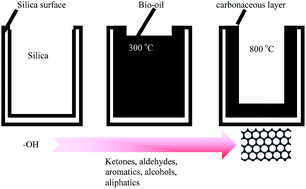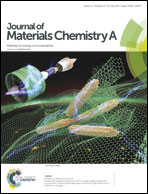Green preparation of tuneable carbon–silica composite materials from wastes†
Abstract
Bio-oil has successfully been utilized to prepare carbon–silica composites (CSCs) from mesoporous silicas, such as SBA-15, MCM-41, KIT-6 and MMSBA frameworks. These CSCs comprise a thin film of carbon dispersed over the silica matrix and exhibit porosity similar to the parent silica. The surface properties of the resulting materials can be simply tuned by the variation of preparation temperatures leading to a continuum of functionalities ranging from polar hydroxyl rich surfaces to carbonaceous aromatic surfaces, as reflected in solid state NMR, XPS and DRIFT analysis. N2 porosimetry, TEM and SEM images demonstrate that the composites still possess similar ordered mesostructures to the parent silica sample. The modification mechanism is also proposed: silica samples are impregnated with bio-oils (generated from the pyrolysis of waste paper) until the pores are filled, followed by the carbonization at a series of temperatures. Increasing temperature leads to the formation of a carbonaceous layer over the silica surface. The complex mixture of compounds within the bio-oil (including those molecules containing alcohols, aliphatics, carbonyls and aromatics) gives rise to the functionality of the CSCs.

- This article is part of the themed collection: 2015 Journal of Materials Chemistry A Hot Papers

 Please wait while we load your content...
Please wait while we load your content...